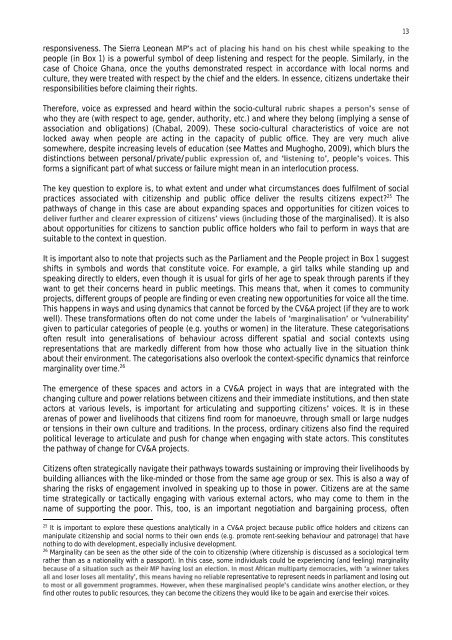Citizen voice and state accountability: Towards ... - Capacity4Dev
Citizen voice and state accountability: Towards ... - Capacity4Dev
Citizen voice and state accountability: Towards ... - Capacity4Dev
- No tags were found...
You also want an ePaper? Increase the reach of your titles
YUMPU automatically turns print PDFs into web optimized ePapers that Google loves.
esponsiveness. The Sierra Leoneanpeople (in Box 1) is a powerful symbol of deep listening <strong>and</strong> respect for the people. Similarly, in thecase of Choice Ghana, once the youths demonstrated respect in accordance with local norms <strong>and</strong>culture, they were treated with respect by the chief <strong>and</strong> the elders. In essence, citizens undertake theirresponsibilities before claiming their rights.Therefore, <strong>voice</strong> as expressed <strong>and</strong> heard within the socio-culturalwho they are (with respect to age, gender, authority, etc.) <strong>and</strong> where they belong (implying a sense ofassociation <strong>and</strong> obligations) (Chabal, 2009). These socio-cultural characteristics of <strong>voice</strong> are notlocked away when people are acting in the capacity of public office. They are very much alivesomewhere, despite increasing levels of education (see Mattes <strong>and</strong> Mughogho, 2009), which blurs thedistinctions between personal/private/ , peo Thisforms a significant part of what success or failure might mean in an interlocution process.The key question to explore is, to what extent <strong>and</strong> under what circumstances does fulfilment of socialpractices associated with citizenship <strong>and</strong> public office deliver the results citizens expect? 25 Thepathways of change in this case are about exp<strong>and</strong>ing spaces <strong>and</strong> opportunities for citizen <strong>voice</strong>s tothose of the marginalised). It is alsoabout opportunities for citizens to sanction public office holders who fail to perform in ways that aresuitable to the context in question.It is important also to note that projects such as the Parliament <strong>and</strong> the People project in Box 1 suggestshifts in symbols <strong>and</strong> words that constitute <strong>voice</strong>. For example, a girl talks while st<strong>and</strong>ing up <strong>and</strong>speaking directly to elders, even though it is usual for girls of her age to speak through parents if theywant to get their concerns heard in public meetings. This means that, when it comes to communityprojects, different groups of people are finding or even creating new opportunities for <strong>voice</strong> all the time.This happens in ways <strong>and</strong> using dynamics that cannot be forced by the CV&A project (if they are to workwell). These transformations often do not come undergiven to particular categories of people (e.g. youths or women) in the literature. These categorisationsoften result into generalisations of behaviour across different spatial <strong>and</strong> social contexts usingrepresentations that are markedly different from how those who actually live in the situation thinkabout their environment. The categorisations also overlook the context-specific dynamics that reinforcemarginality over time. 26The emergence of these spaces <strong>and</strong> actors in a CV&A project in ways that are integrated with thechanging culture <strong>and</strong> power relations between citizens <strong>and</strong> their immediate institutions, <strong>and</strong> then <strong>state</strong>actors at various levels, is important for articulating <strong>and</strong> supporting citizen <strong>voice</strong>s. It is in thesearenas of power <strong>and</strong> livelihoods that citizens find room for manoeuvre, through small or large nudgesor tensions in their own culture <strong>and</strong> traditions. In the process, ordinary citizens also find the requiredpolitical leverage to articulate <strong>and</strong> push for change when engaging with <strong>state</strong> actors. This constitutesthe pathway of change for CV&A projects.<strong>Citizen</strong>s often strategically navigate their pathways towards sustaining or improving their livelihoods bybuilding alliances with the like-minded or those from the same age group or sex. This is also a way ofsharing the risks of engagement involved in speaking up to those in power. <strong>Citizen</strong>s are at the sametime strategically or tactically engaging with various external actors, who may come to them in thename of supporting the poor. This, too, is an important negotiation <strong>and</strong> bargaining process, often25It is important to explore these questions analytically in a CV&A project because public office holders <strong>and</strong> citizens canmanipulate citizenship <strong>and</strong> social norms to their own ends (e.g. promote rent-seeking behaviour <strong>and</strong> patronage) that havenothing to do with development, especially inclusive development.26Marginality can be seen as the other side of the coin to citizenship (where citizenship is discussed as a sociological termrather than as a nationality with a passport). In this case, some individuals could be experiencing (<strong>and</strong> feeling) marginalitye representative to represent needs in parliament <strong>and</strong> losing outfind other routes to public resources, they can become the citizens they would like to be again <strong>and</strong> exercise their <strong>voice</strong>s.13
















